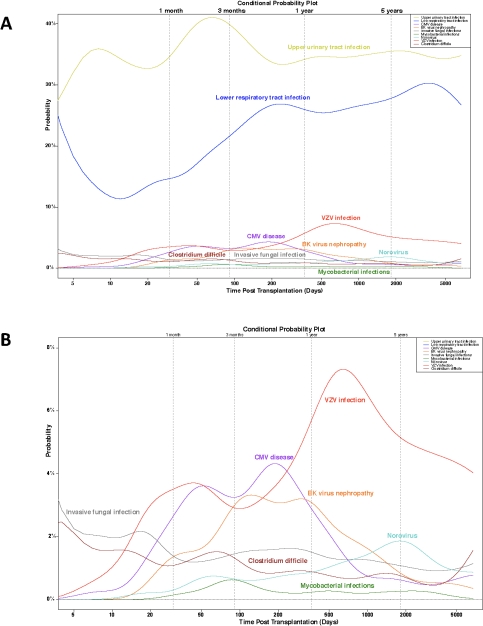Natural History and Determinants of Infectious Complications after Kidney Transplantation: A Nationwide Prospective Population Based Cohort
Paris Transplant Group, Paris, France.
Meeting: 2018 American Transplant Congress
Abstract number: 438
Keywords: Infection, Kidney transplantation, Survival
Session Information
Session Name: Concurrent Session: Kidney Infectious - Pot-Pourri
Session Type: Concurrent Session
Date: Tuesday, June 5, 2018
Session Time: 2:30pm-4:00pm
 Presentation Time: 2:30pm-2:42pm
Presentation Time: 2:30pm-2:42pm
Location: Room 608/609
Background: Although Infectious complications are a major cause of morbidity and mortality in KTR, little is known about their natural history and determinants at a population level.
Methods: Nationwide cohort including all consecutive KTR from 6 French centers from 2000 to 2012 with prospective uniform and quality-checked extensive data collection including a systematic record of post-transplant infectious complications (site and pathogen involved).
Results: 8,398 KTR were included with a median follow-up time post-transplant of 7 years (IQR 4-10), corresponding to 56,916 patients-years. During the follow-up, 11,398 infectious complications were diagnosed in 4,839 patients. The first infection episode occurred after a median 184 days (IQR 23–852) after KT. Infections were bacterial (n=9,123, 79.9%), viral (n=1,930, 16.9%), fungal (n=297, 2.6%) or parasitic (48, 0.2%). Main sites were upper genito-urinary tract (n=4,232, 37.1%), followed by lower respiratory tract (2,703, 23.7%), blood stream (n=908, 8%), skin (750, 6.6%), GI tract (n=616, 5.4%), and upper respiratory tract (524, 4.6%). Main pathogens were Enterobacteriaceae (3,094, 28.1%), Staphylococcus sp (771, 7%), VZV (496, 4.5%), Enterococcus sp (482, 4.4%), Pseudomonas sp (386, 3.5%), CMV (209, 1.9%), BK virus (191, 1.7%), HSV (156, 1.4%), norovirus (111, 1%); P. jiroveci (96, 0.9%), Candida sp. (94, 0.9%), and Aspergillus sp. (85, 0.8%). Figure 1. Infectious episodes were associated with an increased risk of death (p<0.001). The main independent determinants of time to infection were: recipient age, female gender, history of diabetes, hypertension, major cardiovascular events, induction treatment, eGFR at 1-year post KT, acute rejection, donor age and graft rank (p<0.001 for all comparisons).
Conclusion: In this first population-based assessment of infections after KT. These results suggest the potential for a data driven approach of infectious disease for improving patients risk stratification that would help clinicians in the clinical management and immunosuppressive regimens adaptation. 
CITATION INFORMATION: Scelma A., Perrier M., Lortholary O., Girerd S., Kerleau C., Garrigues V., Buron F., Kamar N., Legendre C., Bouatou Y., Lefaucheur C., Giral M., Loupy A. Natural History and Determinants of Infectious Complications after Kidney Transplantation: A Nationwide Prospective Population Based Cohort Am J Transplant. 2017;17 (suppl 3).
To cite this abstract in AMA style:
Scelma A, Perrier M, Lortholary O, Girerd S, Kerleau C, Garrigues V, Buron F, Kamar N, Legendre C, Bouatou Y, Lefaucheur C, Giral M, Loupy A. Natural History and Determinants of Infectious Complications after Kidney Transplantation: A Nationwide Prospective Population Based Cohort [abstract]. https://atcmeetingabstracts.com/abstract/natural-history-and-determinants-of-infectious-complications-after-kidney-transplantation-a-nationwide-prospective-population-based-cohort/. Accessed December 26, 2025.« Back to 2018 American Transplant Congress
